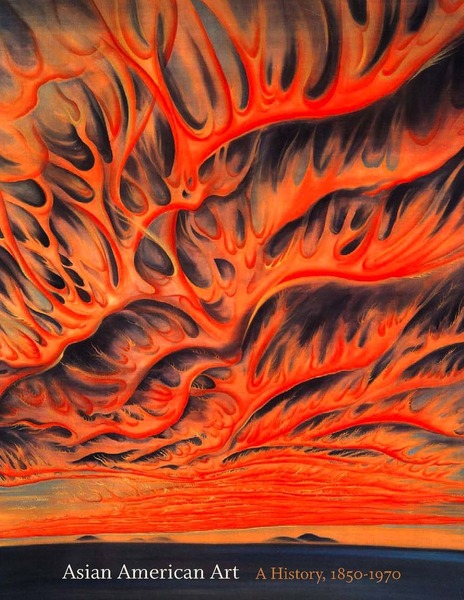
FOR IMMEDIATE RELEASE
I was very moved when I first opened Asian American Art. Here were artists and their works that have long been lost, forgotten, and in some cases, deliberately hidden for decades. I was impressed by the comprehensive, thoughtful, and sometimes provocative approach taken in the essays, but to see the art itself! In these pages, we see the breadth and range of experience, styles, and obstacles both artistic and personal. – Lisa See, author, Peony in Love (2007)
Asian American Art: A History, 1850-1970 (release date: September 29, 2008) is the most comprehensive study to date of art produced by artists of Asian ancestry working in the United States. This groundbreaking volume not only presents these artists’ important contributions to and influences on American art and culture, but also details the political and social conditions that have delayed the recognition of these achievements.
The volume spans the period from the Gold Rush to the late 1960s, when a heightened civil rights and cultural consciousness began to emerge along with the emergence of Asian American Studies as a subject of academic study. It covers several of the most important centers of Asian American creative activity – from New York to the West Coast cities of Seattle, San Francisco, and Los Angeles, and exhumes the careers of more than two hundred artists – most of whom are seen here for the first time in many decades, some in more than a century. Profiled artists include painters, sculptors, printmakers, photographers, textile artists, and ceramists who were active for a decade or more in the United States.
Asian American Art’s inclusive approach to residency helps retrieve the careers of many immigrant artists who, because they were not allowed to become U.S. citizens, often returned to their countries of birth and have not been properly historicized in the United States or Asia. It also reflects the social demographics of its time, with artists of Chinese and Japanese ancestry predominating and those of Filipino and Korean ancestry present to a lesser extent. The volume includes prominent artists such as Dong Kingman, Yun Gee, Yasuo Kuniyoshi, Isamu Noguchi, Ruth Asawa and Chang Dai-chien as well as important but less familiar figures such as Eitaro Ishigaki, Lai Yong and Yoshida Sekido, who had prominent careers during their lifetimes, yet are little known today.
The volume presents familiar places, people and experiences in unfamiliar ways, allowing us to see America with “new eyes.” Chiura Obata’s Setting Sun: Sacramento Valley and Chang Dai-chien’s vision of Yosemite, Autumn Mountains in Twilight, offer fresh perspectives on the American landscape. It explores the engagement of Asian American artists with larger national and international art movements. And, historical events such as World War II are understood in new ways through the personal experiences of both artists who were interned and those who were not.
The volume delves into the political milieu of these artists by exploring ideas of attachment to heritage prompted by social alienation and the quandary of exile, displacement during the height of racial antagonism in the United States, and persecution for their political beliefs. It investigates the varied ways in which these artists thought about issues such as the “West,” and “East,” man and nature, the city, and race.
Asian American Art features ten essays by preeminent scholars: Karin Higa, Mayching Kao, Margo Machida, Valerie Matsumoto, Kazuko Nakane, Dennis Reed, Tom Wolf and the volume’s editors. It includes a detailed biographical directory of 159 artists who worked in California from the Gold Rush until 1965, and art/history chronology that places the careers of these artists against the backdrop of larger political and cultural events. Most captivating are the more than 400 reproductions of Asian American art and help bring the artists and their times to life.
As Mark Johnson (one of the editors of the volume) remarks, “Our goal is to suggest a radical reenvisioning of Asian American art to include a long view of its own history. . . . We hope the magnificence of the many constellations that appear within these pages provides sources for future discovery, appreciation, and dialogue as the field of Asian American art continues to expand and inspire.”
The publication has been in development for more than a decade and is supported by the National Endowment for the Humanities, Stanford University, and the Getty Foundation. This research also provides the basis for a related exhibition organized by the Fine Arts Museums of San Francisco, which will open at the de Young Museum in October of 2008.
Gordon H. Chang is a professor of history at Stanford University and codirector of the Stanford Asian American Art Project. He is the author of many books and essays, including Friends and Enemies: The United States, China, and the Soviet Union, 1948–1972 and Morning Glory, Evening Shadow: Yamato Ichihashi and His Internment Writings, 1942–1945.
Mark Dean Johnson is a professor of art at San Francisco State University and co-director of the Stanford Asian American Art Project. He has collaboratively organized exhibitions such as Chang Dai-chien in California and With New Eyes: Toward an Asian American Art History in the West, and conferences including Expanding American Art History to Reflect Multiethnic Diversity. He is also the editor of At Work: The Art of California Labor.
Paul J. Karlstrom, former West Coast regional director of the Smithsonian’s Archives of American Art, writes about modern and contemporary art in the United States. He is the editor of On the Edge of America: California Modernist Art, 1900–1950 and has contributed to major studies of Diego Rivera, Jacob Lawrence, and Yun Gee.
•BACK•